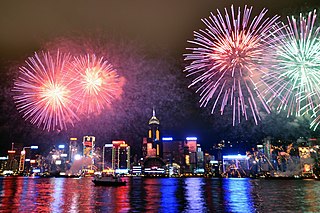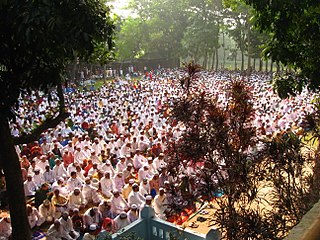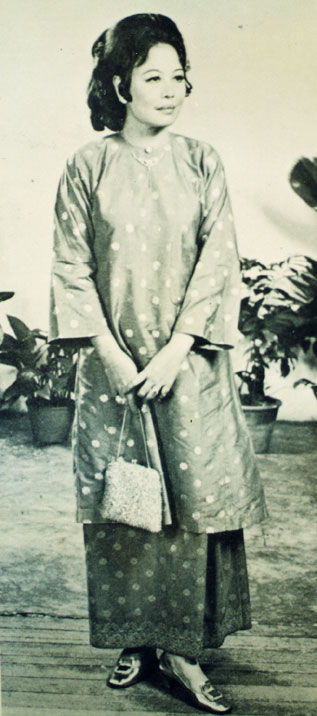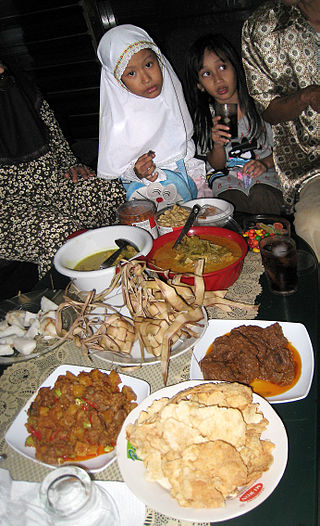
Eid al-Fitr is the earlier of the two official holidays celebrated within Islam. Eid al-Fitr is celebrated by Muslims worldwide because it marks the end of the month-long dawn-to-dusk fasting of Ramadan. Eid al-Fitr falls on the first day of Shawwal in the Islamic calendar; this does not always fall on the same Gregorian day, as the start of any lunar Hijri month varies based on when the new moon is sighted by local religious authorities. The holiday is known under various other names in different languages and countries around the world. The day is also known as the First Eid or as the Lesser Eid by some Muslim communities.

Lunar New Year is the beginning of a new year based on lunar calendars or, informally but more widely, lunisolar calendars. Lunar calendars follow the lunar phase while lunisolar calendars follow both the lunar phase and the time of the solar year. The event is celebrated by numerous cultures in various ways at diverse dates.
Eid al-Adha is the second of the two main holidays in Islam alongside Eid al-Fitr. It falls on the 10th of Dhu al-Hijja, the twelfth and final month of the Islamic calendar. Celebrations and observances are generally carried forward to the three following days, known as the Tashreeq days.

Islam in Malaysia is represented by the Shafi‘i school of Sunni jurisprudence. Islam was introduced to Malaysia by traders arriving from Persia, Arabia, China and the Indian subcontinent. It became firmly established in the 15th century. In the Constitution of Malaysia, Islam is granted the status of "religion of the Federation" to symbolize its importance to Malaysian society, while defining Malaysia constitutionally as a secular state. Therefore, other religions can be practiced legally, though freedom of religion is still limited in Malaysia.

Public holidays in Malaysia are regulated at both federal and state levels, mainly based on a list of federal holidays observed nationwide plus a few additional holidays observed by each individual state and federal territory. The public holidays are a mix of secular holidays celebrating the nation and its history, and selected traditional holidays of the various ethnic and religious groups that make up the country.

Shawwal is the tenth month of the Islamic calendar. It comes after Ramadan and before Dhu al-Qa'da.

The Culture of Malaysia draws on the varied cultures of the different people of Malaysia. The first people to live in the area were indigenous tribes that still remain; they were followed by the Malays, who moved there from mainland Asia in ancient times. Chinese and Indian cultural influences made their mark when trade began with those countries, and increased with immigration to Malaysia. Other cultures that heavily influenced that of Malaysia include Persian, Arabic and British. The many different ethnicities that currently exist in Malaysia have their own unique and distinctive cultural identities, with some crossover.

Eid Mubarak is an Arabic phrase that means "blessed feast or festival". The term is used by Muslims all over the world as a greeting to celebrate Eid al-Fitr and Eid al-Adha. This exchange of greetings is cultural tradition and not part of any religious obligation.
DeepaRaya is a name for the Deepavali and Hari Raya festivals, which are traditionally celebrated by Hindus and Muslims, respectively, in Malaysia as well as in Singapore. The word came about because of the occasional coincidental timing of the Hindu festival Deepavali and the Muslim festival of Eid ul-Fitr, referred to in the Malay language as Hari Raya Aidilfitri. In this sense, it is similar to the portmanteau of Kongsi Raya, which combines the Chinese New Year with Hari Raya.

Eid prayers, also referred to as Salat al-Eid, are holy holiday prayers in the Islamic tradition. The literal translation of the word "Eid" in Arabic is "festival" or "feast" and is a time when Muslims congregate with family and the larger Muslim community to celebrate.
This is a list of the public holidays of the Malaysian state of Sabah and Sarawak. Dates given are those on which the holidays were celebrated in 2006. Some are Malaysian national holidays, while others are celebrated only in Sabah and Sarawak.

Lemang is a Minangkabau traditional food made from glutinous rice, coconut milk, and salt, cooked in a hollowed bamboo tube coated with banana leaves in order to prevent the rice from sticking to the bamboo. Originating in Indonesia, it is also found in Singapore, Malaysia, and Brunei, as similar dishes made from sticky rice in bamboo are common throughout Mainland Southeast Asia.

A green envelope is a Malay adaptation of the Chinese red envelope custom. During the festival of Eid ul-Fitr, Muslims in Malaysia, Brunei, Singapore, and Indonesia hand out money in green envelopes to guests who visit their homes. The colour green was chosen for its association with the Islamic paradise. The idea of handing out green envelopes is based on the Islamic concept of zakat, where every Muslim is required to provide at least 2.5% of their wealth to the needy. However, Malays now hand out these green envelopes during Aidilfitri not only to their poor guests, but also to the middle class and to the upper class. The amount of money depends on how much the host can afford to give their guests.
Hari Raya songs are Malays Eid ul Fitr songs.

Baju Kurung is a traditional attire of Malays and traditionally worn by women in Brunei, Indonesia, Malaysia, Singapore and southern Thailand. This type of traditional attire is the national dress of Brunei and Malaysia. In Indonesia, this dress is also worn as a regional attire, commonly observed on the island of Sumatra, particularly by the ethnic Malay and Minangkabau women.

Lebaran is the Indonesian popular name for two Islamic official holidays, Eid al-Fitr and Eid al-Adha in Indonesia, and is one of the major national holidays in the country. Lebaran holiday officially lasts for two days in the Indonesian calendar, although the government usually declares a few days before and after the Lebaran as a bank holiday. Many individuals or families, especially Muslims take paid time off from their workplace during these days.

Eid in the Square is an annual Muslim festival held the first Saturday after the Islamic religious holiday of Eid al-Fitr at Trafalgar Square in Westminster, London, England. The event has grown to become one of the key cultural highlights of London's events calendar and sees attendances of over 25,000.

Ketupat, or kupat, or tipat is a Javanese rice cake packed inside a diamond-shaped container of woven palm leaf pouch. Originating in Indonesia, it is also found in Brunei, Malaysia, Singapore, southern Philippines, southern Thailand, Cambodia and Laos. It is commonly described as "packed rice", although there are other types of similar packed rice such as lontong and bakchang.

"Hari Kemenangan" is a single by Malaysian artist, Siti Nurhaliza. Written by Siso Kopratasa and produced by Pak Ngah Suhaimi, it was released on 20 June 2016 as a special single for Eid al-Fitr. This single marked her first Eid al-Fitr single after she recorded the last one 10 years ago. It was also produced after Siti release her eid album Anugerah Aidilfitri in December 2003.

Kongsi Raya is a 2022 Malaysian Malay-language comedy-drama film directed by Teddy Chin. It tells the story of a Chinese chef who is in love with a Malay TV producer, but their relationship faces objections from both of their long-feuding chef fathers. Things gets out of hand when the fathers decide to rival in a live TV cooking competition showdown.